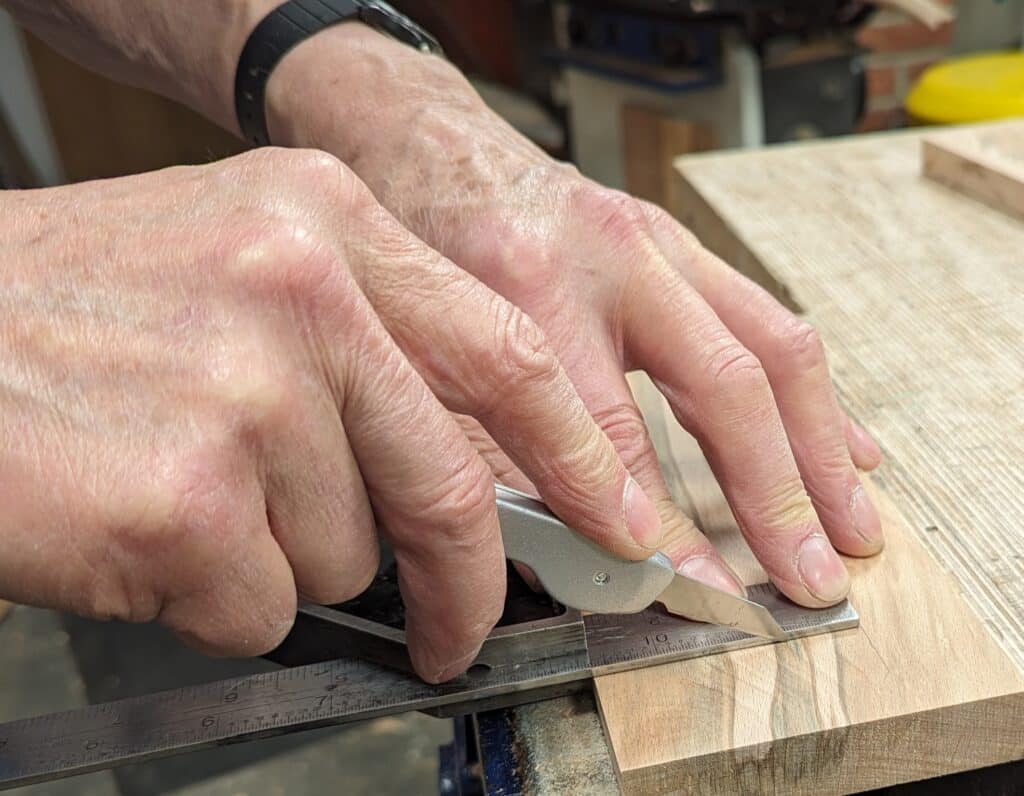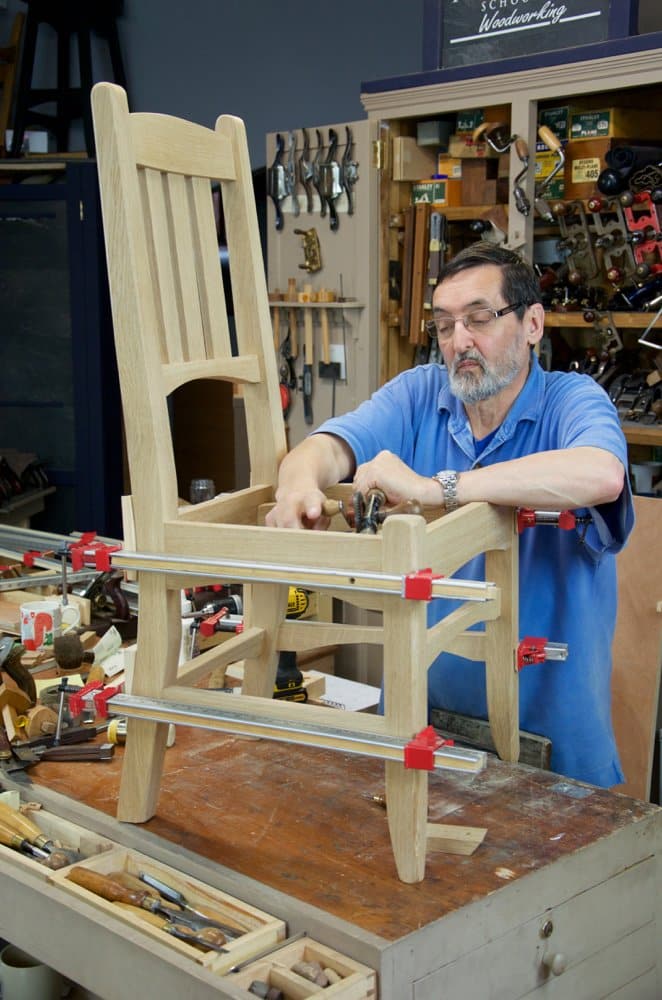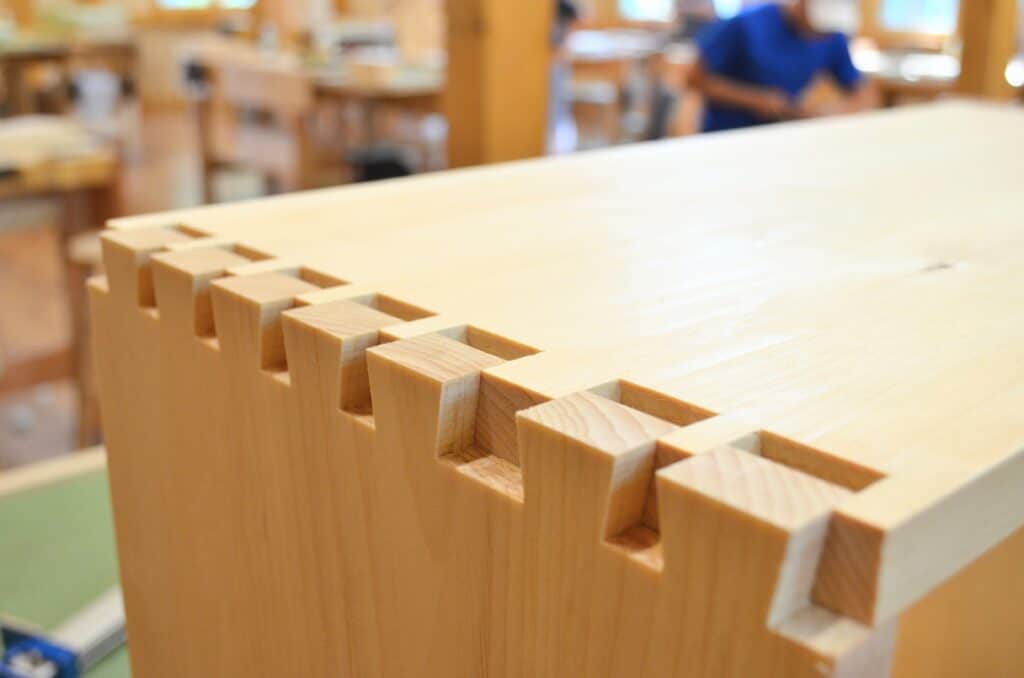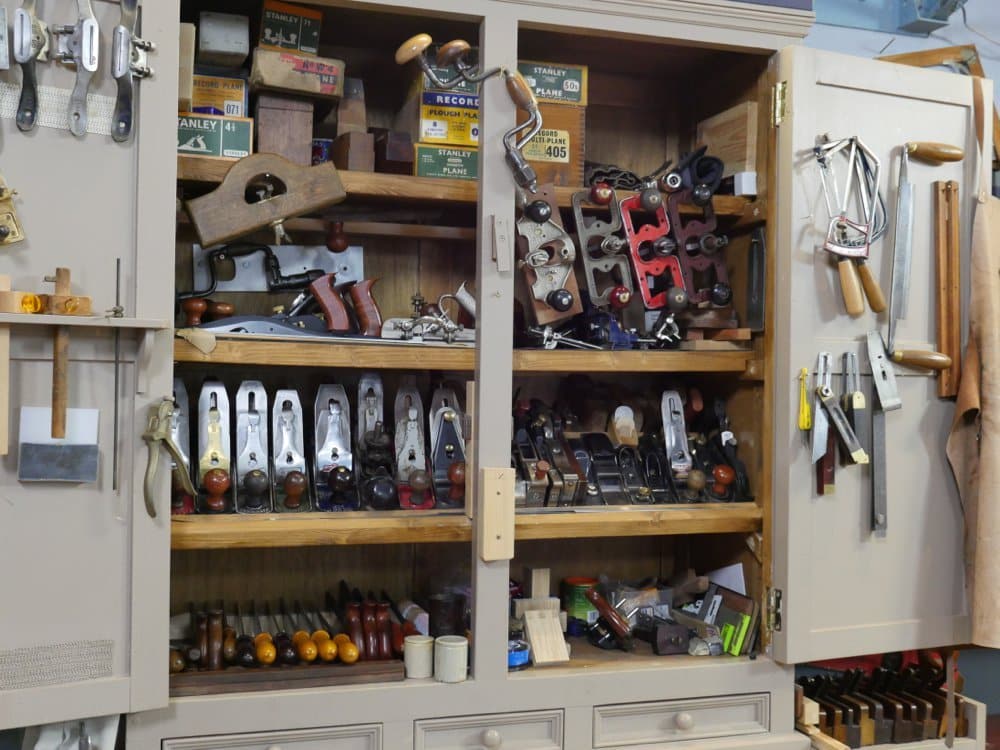The Silent and Isolative
As a boy `I worked near to a very old man working far beyond his retirement age, whatever that is. He would have been about the age I am now plus five more years. 80 years for him would have meant 67 years standing alongside a bench vise and working six days a week. I’m not far behind Bill. This is now my 60th year of full-time woodworking and making with my hands in the same way that he did. There was no size to this living survivor going through two world wars. He was a frugal man making no demands on life beyond the few square feet where he stood every day in his bib-n-brace overalls turned up several times at the ankle with the turn-ups filled always with the wood dust, chips and the shavings of his work.

Working alongside Bill, and with George at my elbow, I became conscious of two things in the man. One, his acceptance of self-silence and the isolation he imposed on himself as he worked and then too his percipience that was in no way impaired by his age. Along with George, he was a most sensitive and benevolent man. I could always hear the respect George had for Bill when he spoke of him and to him. George considered him a man of substantial character and an example of excellence whereas others seemed to despise his stand for right. When the men took on a turn to mock Bill, George always stood between them and him. George’s height stood him in good stead. He had a presence to him that no one ignored and he could disarm any other in the shop by a smile or a nod or a simple clipped word that was never ignored. He never allowed another to be the butt of a joke, especially the older men or the young vulnerables.

I work most days in the isolation of my working where the work itself separates me in an isolating silence I love to be immersed by. This encapsulation stops all time and in the isolation minutes can become hours and hours become minutes: such is the power of silence and isolation in creative work and space. In the noise of hammer beats, hammer taps and then saw strokes too sound is suspended as a rhythmic pulse like the silent heartbeat in our bodies. These are the rhythms of life felt in the planting and harvesting of crops, cycles where life repeats its reproductive life by perpetual replication of leaves on trees and the birth of all things. Somehow I still connect to the mentors that never spoke of their feelings or thoughts much at all but capably projected such things into the atmosphere surrounding them in their work. Bill always worked diligently and never allowed himself to be distracted by banter and the chitchat others had throughout the day. He never stopped to smoke as the other men tended to at every opportunity. His cigarette simply hung from his lips and clouded around his eyes as he worked. Or then again it burnt the corner of his bench in the same place. To Bill, idle chatter was theft from his employer. If anyone was sacked, it was never Bill. Even though his age disadvantaged him he was never considered for sacking because he still produced more than the younger men.

My work eventually became consistent and predictable. Much of what I do in the day-to-day is highly repetitive and I sometimes wonder why it so keeps my attention. I understand now that most people want perpetual change to stimulate and make the work interesting but don’t realise that this kind of attention shift and change comes at the cost of the mastery I speak of. Having made a hundred thousand of the two or three joint types I use to make and build every day, much of my work remains the same day in and day out and yet everything I do is really quite different by the wood that constantly changes by its very nature. The variations in the working of the wood are usually minor but when I cut the line of a dovetail, though I could have done a hundred such cuts in the previous week or two, it’s always different. I have never once found the work boring or particularly tedious. People watching me working, creating something painstakingly, often comment on my need for patience but that’s not the case at all. Every cut I make is individual even though repeated. Through this, we add character to the work and the slight straying of the saw stroke leaves the imprint of the maker in the work. Though the silence of occupying your job, the task in hand, and being isolated into it, is always important, the outcome of these pocketed spheres is an indescribable contentment that comes to me in only a handful of ways. This is how handwork works and this is what we are robbed of using other methods where something hard and rigid and dare I say inuman stands austerely between man’s hand and the wood’s working.

In my apprenticeship days, the experience of silence and isolation was more the scarcity and rarity, with anxious moments prevailing and yet George was always solid in this one thing. “You’ll get there Paul. You cannot rush mastery, you must just persevere.” My anxieties back then were in my rarely achieving the results others there seemed to take for granted. The saw cuts, unmarked and often gauged by eye alone, always matched the angles and the plane strokes parted away the unwanted with the precision of a Swiss clockmaker. It took me about four years before I found myself settling into my craft. The cuts matched all the more but more than that, George asked me to do things he felt I could do without worrying about losing some of the work he and I had worked on. It wasn’t about pride so much as simply being entrusted with something I knew mattered to George. The first time he asked me to cut a dovetail for a piece magnified the significant trust he was placing in my ability. I wasn’t as relaxed then as I am now. I never now question whether a dovetail will fit and fit perfectly. My work is predictable and relaxed. The saw and chisels held are firmly relaxed and firmly flexed according to feelings and sounds. In the working, we seldom consider these things and would rarely if ever discuss them.

As I have grown in my craft, I still hold a measure of reserve knowing that a miscut might happen but I’m unworried by it because for the thousand cuts I make only one will be a miscut and most such cuts will go unnoticed. There is a common phrase amongst makers in every craft. It’s been accepted even though I find it silly: “Woodworking is mostly about knowing how to fix your mistakes.” That’s not altogether the case because we learn as we go and then, through understanding our tools, the wood and our own limitations anticipate a likely possibility. Eventually, we do get to know what could actually go wrong by this or that action and through the experience of past mistakes know how to disallow the possibility. Planing end grain always benefits from a knifewall: first, you ensure you have a pristine sharp line to work to and this then minimises the friction on the sole of the plane that can indeed stress the grain at the out-cut of a skewed presentation force of which breaks the corner causing corner fraction. I rarely make any cross-grain cut without first establishing a knifewall.

With a million such understandings, the isolation and silence of your working leads to an inner contentment few ever actually realise in their working. I understand the use of cute sayings; “Measure twice, cut once.” and such, but of course, for a millennia before, we always measured twice and more often sometimes, along with cross-referencing we are always involved in in other ways. We just didn’t need earworms to remind us that a cut made can often not be reversed so the experience of a costly miscut was a good lesson learned and we moved on into a contented way of working and seldom made the same mistake twice.
Even in my early-day insecurities I still enjoyed the 100% need for continuous learning and had I the need to do it again I would be there without any hesitation. Not knowing things and moving in the sphere of novice was critical. I am probably one of the few men who can truly say I never faltered in my love to learn my craft.


Well said Paul. I find myself as I age ruminating frequently upon varied topics. The remembrances and their applications are of great importance. I regret my grandchildren are not in a position to learn skills that transfer to attitudes and actions that have the possibility of impacting others positively; but I try.
Legacy is valuable. Thank you for the reminder. May we all be a bit more like George, Bill, and Paul this day!
Be blessed, Sir!
You could have been a professional writer! Mesmerizing!
could be? he already is!
He is!
Wonderful writing about an important component of mastery. I am not much younger than you and have only just started my woodworking journey, so I am unlikely to fully experience what you do in this arena. Still, I think I can relate. I do open water rowing in a recreational scull. To the outside observer, it is a simple repetitive action to move the body back and forth in driving the oars. While there is certainly some truth to that, each stroke must be tailored to the waves, both natural and man-made, and to the adjustments in balance those waves require. The water is always changing and it’s seldom that the optimal heading coincides with the desired heading, making each stroke unique. Although these things tend toward second nature over the years, one’s mind can never stray too far from the task at hand if getting home dry is desirable!
Glad you are mending well. I always enjoy your work and your stories. Well said!
I’m amazed at the quality and substance of your writing, Paul. When I need to read something that doesn’t contain the disrespect for all things decent that pervades society today, it’s nice to know you can come here and there is sanity. I spent 8 years as a young man learning a building trade in a 3 year apprenticeship through 5 years as a journeyman, before changing careers and spending a career in the oil industry in Texas. I still remember things the “old timers” taught me about pride in your work and craftsmanship. Thanks for keeping those traits alive.
As you say, in this day of social media and all the disrespect, hate and simply repeating all things negative it is wonderful to hear of respect, care for one’s work and fellow man.
My grandfather was a tool and die maker and I heard measure twice and cut once a thousand times. I retake measurements a lot because it saves time from starting over. Mistakes now have the opportunity to become “design changes”,and the feel of the tool operating well or joints fitting well is a feeling that I treasure. Thanks for your articles and glad to see you are better from your accident.
Paul,
We think A LOT alike.
I love your writing and videos.
Chuck W
“his acceptance of self-silence and the isolation he imposed on himself as he worked”: I’m only a few years younger than you Paul, and a novice woodworker, but it’s that silence and isolation that has attracted me to hand tool woodwork. So far, I’ve made mostly what I call “kindling”, but the sheer joy of the quiet strokes of the tools (apart from chopping mortises!) make it both fascinating and therapeutic. Full disclosure – I do like a little soft music in the background. Is that cheating? 🙂
After reading Paul’s blog and seeing his skill-full work I have a lot of respect for Paul.
I have loved working with wood since leaving school and only wish now that I had chosen woodworking instead of working in metal in a engineering company. I totally agree with Paul about being immersed in the workshop making a project made of wood I am in my in my own little world totally oblivion to the outside world.
Robin C Bishop
26th of August 2024
I cut it twice and it’s still too short!
Remember..if you cut to wrong length….its only short one end. 🙂
Thanks Paul for mentioning the challenge of the early days as well as mentioning it took about 4 years to settle in. You’ve talked about Bill and George over the years. Do you happen to know how old Bill was before he passed and if he was able to keep working till the end?
Hello, Mr. Sellers;
Thank you, sir, for sharing your experience and knowledge.
I’m 69, and I think I should have began to focus on hand tool woodworking much earlier.
Unfortunately, there were too many ‘distractions’ and I wasn’t mature enough to understand what was ( and is) truly important.
While there are other very important activities, there is something about working with our hands, making or repairing useful items.
I have always been impressed with the need and benefit of being immersed in work.
I really appreciate your insight.
BTW, I’m glad your surgery helped, my grandfather never enjoyed such.
Also, I’m glad your recovery continues to go well with you.
Have a GREAT day, Neighbor!
Sincerely,
jon
Paul, although the knowledge and experience you share is so valuable and inciteful, it’s in the telling I enjoy the most. The writing and poetry you share are a joy. Thank you.
Hi Paul,
You talk about your Mentors In Joinery and it reminds me Off when I did my Shopfitting/Joinery Apprenticeship at a Company in Birmingham Uk Called Cadwalladers Where The Joiners would Mostly Be Retirement Age Puffing away at there Smoke Pipes around there Benches as they did Craft.
I Remember One Joiner Called Fred saying to me with his Glasses perched on the bottom of his nose Puffing away at his Pipe Saying-
‘Look after your Tools and they Will Look After You’.
Never a Truer Word Said.
Excellent article.
I have a teenager working with me, who has one of those plastic ‘snails’ plugged into his ear, if he gets the chance.
How can anyone go through the day with a constant distraction of background noise?
“Get that thing out of your ear” is a phrase often used in the workshop …
Well, I certainly would never allow it at my workbench or in my workshop. They are only half there if they are deaf to the work so best find another job. It’s a simple solution. My time in mentoring is worth a hundred times more than anything gleaned from headphone information.
Same as the folks you see walking or running in the countryside, with earphones, completely oblivious to the sounds of nature… or the potential of being harmed by not being aware of people or vehicles around them… I just don’t understand it!
Dear Peter, Dear Paul,
here is another point of view which you could consider: in my family there are some adults and teenagers suffering from „Attention Deficit Disorder“ (ADD). Background noise helps them (or makes it possible in the first place depending on mood and stress level) to stay focused on what is in front of them (writing, painting, homework, sewing, woodworking,…). The noise can be music or from a tv show or movie. Their brain works completely different. And more and more Teenagers have AD(H)D it is not „only a trend“. Of course when it comes to talking they need to switch the noise of. Using headphones or ear plugs is just polite as the don‘t want to disturb other by hearing it loudly with speakers. It is a littlebit difficult to get their attention as they then are very often superfocussed. Best is to step in front of them and wave a hand. ADD is sometimes difficult to discover when it is not accompanied by hyper activity. There are online selftests to get a first Impression. But I agree: Most of the people do not have AD(H)D and it is just sad as they get distracted and miss a lot. Best Regards, Thomas
I never allow any distractions while working. When using hand tools, the sounds and smells of the work would be diminished, and when using machines both safety and the speed one can make a mistake are too easily compromised.
Your description of Bill reminded me of Fred Hamm in my father’s shop. No one (probably including Fred himself) knew how old he was. My guess is that he was in his mid to late 70’s. Fred was uneducated other than in our craft, and couldn’t read or write. Yet, Fred was one of the most valuable men in the shop. He never took a break, or a sick day, was always on time for work, and like your Bill, outproduced everyone else with few, if any, mistakes.
Thanks again Paul for your comments and memories.
Your comments are so true. I often find myself exhausted and bored at parties, and long for the solitude of my workshop. There is peace in silence…
My youngest daughter and I went to college about the same time. Me for a second time determined to do it the right way this time. And I did.
She would have assignments that puzzled her. I offered to help. In discussing the work with her, I would learn there was a word, or several, that went undefined.
Dad (Me) would say for the umteenth time, “HOW DO YOU KNOW WHAT YOU’RE READING IF YOU DON’T KNOW WHAT THE WORDS MEAN?”
Go back and learn what the words mean. Take notes. Learn your language so you might actually know what our ancestors left for us in the way of wisdom. Learn our language so you might be able to better share what you’re feeling and thinking. Learn our language. That’s part of why you’re here, in college. Not to take a test, but to learn.
The first time I want to college, the texts, the words, meant nothing to me. It was all bull, and I thought it was just dumb. The words were foreign. English was some language I refused to be familiar with.
Now I keep a five by seven index card or the envelope from some junk mail turned inside out to list the word in question, the page it was on, and the paragraph it was hidden in. All for later dictionary time and revisiting for meaning. So many things to learn if we so choose.
Today’s word was, “percipience.” (page 1, para 2) I looked it up and can now use it in a sentence.
Example:
“Percipience,” now that’s a good word!
Teach on my good Mr. Sellers. I’m here to learn.
Ha! Glad I’m not the only one.
I have just taken up hand tool woodworking at age 71 and I expect it to keep me fit and young until I am 80 or more. I am making my work bench now which is a hard slog but seeing 4 identical laminated legs emerge from a crude ceiling joist using only saw, plane and right angle square is very satisfying. It increases my heart rate and forces me to focus, so in a sense it is active meditation. All my working life I never produced anything that I could proudly point at and say “I made that” but now I can. Apparently it takes 10,000 or so hours to become top of your craft and unless you use power tools there is no short cut which is why apprentices start young. Power tools do not teach you to read wood and work with it in order to get the best from it, I find that aspect of Pauls handed down experience very satisfying. Paul demonstrates exceptionally well that even with his skill and practice it requires effort to saw and plane – unlike some uTubers who demonstrate a few strokes of a perfectly set smoothing plane on a perfectly prepared piece of wood on a perfect bench and make it look effortless. But of all his skills I think it is Pauls casual chisel skills that sets him apart because that embodies the many years of practice needed to become a craftsman.
linda história, se parece com a história do meu avô. Um texto eletrizante. parabéns.
From Potuguese this translates to: “Beautiful story, it’s similar to my grandfather’s story. An electrifying text. congratulations.”
Paul, I am a better person and hopefully a becoming a better woodworker from having read your wonderful and inspiring words. Ross
That stillness of time that comes from being totally absorbed in one’s work or activity is now know as Flow State. It is the place where your mind and brain are at their best.
Thank you Paul
(67year old new amateur)
These men you sometimes speak of, your words give them life. We can only hope that someone will do the same for us after we leave this place.
We craftsmen seem to me to have been our own worst enemy by not writing of our craft but working only by passing it on from man to boy through the centuries. So much missing information. In any given day I am using techniques I take for granted by the dozen. By we I do mean people like me who actually served a bona fide apprenticeship under gifted men all of whome eneded their time with sixty and more years experience in the shop amd never wrote a single word of their work, their emotions, the tools or theior feelings. Articles and books are barely ever written by true and time-tested artisans but mostly a journalist here or an artist over there who gleaned a crumb from the tables past and then made just one of something and saw themselves then as a master and indeed were positioned to that level by a hungry world of sadly neglected woodworkers. If only the men I had worked with had written down a small percentage of what they knew the world would be a richer place altogether. And multiply that across all crafts. Imagine how much we would have. Oh, and it wasn’t just woodworking either. They, young and old had moral perspectives on war, politics, educational institutes and much more. We had a dozen converstaions a day between benches to find both common ground and points for discussion that might too lead to disagreement and on to even arguments. It was a rich environment and we were all free with our considerations yet always we spoke respectfully and listened with the same degree of respect. Today, such subjects, although much more expansive with the mass of cultural shifts, cannot be discussed in the “workplace” or indeed freely. It’s as if all subjects have become taboo.